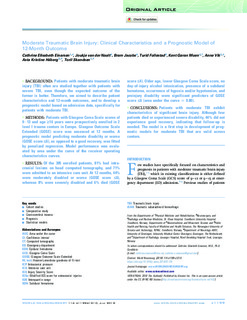| dc.contributor.author | Einarsen, Cathrine Elisabeth | |
| dc.contributor.author | van der Naalt, Joukje | |
| dc.contributor.author | Jacobs, Bram | |
| dc.contributor.author | Follestad, Turid | |
| dc.contributor.author | Moen, Kent Gøran | |
| dc.contributor.author | Vik, Anne | |
| dc.contributor.author | Håberg, Asta | |
| dc.contributor.author | Skandsen, Toril | |
| dc.date.accessioned | 2019-04-02T09:29:54Z | |
| dc.date.available | 2019-04-02T09:29:54Z | |
| dc.date.created | 2018-07-03T12:00:30Z | |
| dc.date.issued | 2018 | |
| dc.identifier.citation | World Neurosurgery. 2018, 114 e1199-e1210. | nb_NO |
| dc.identifier.issn | 1878-8750 | |
| dc.identifier.uri | http://hdl.handle.net/11250/2592882 | |
| dc.description.abstract | BACKGROUND:Patients with moderate traumatic braininjury (TBI) often are studied together with patients withsevere TBI, even though the expected outcome of theformer is better. Therefore, we aimed to describe patientcharacteristics and 12-month outcomes, and to develop aprognostic model based on admission data, specifically forpatients with moderate TBI.-METHODS:Patients with Glasgow Coma Scale scores of9e13 and age‡16 years were prospectively enrolled in 2level I trauma centers in Europe. Glasgow Outcome ScaleExtended (GOSE) score was assessed at 12 months. Aprognostic model predicting moderate disability or worse(GOSE score£6), as opposed to a good recovery, was fittedby penalized regression. Model performance was evalu-ated by area under the curve of the receiver operatingcharacteristics curves.-RESULTS:Of the 395 enrolled patients, 81% had intra-cranial lesions on head computed tomography, and 71%were admitted to an intensive care unit. At 12 months, 44%were moderately disabled or worse (GOSE score£6),whereas 8% were severely disabled and 6% died (GOSEscore£4). Older age, lower Glasgow Coma Scale score, noday-of-injury alcohol intoxication, presence of a subduralhematoma, occurrence of hypoxia and/or hypotension, andpreinjury disability were significant predictors of GOSEscore£6 (area under the curve[0.80).-CONCLUSIONS:Patients with moderate TBI exhibitcharacteristics of significant brain injury. Although fewpatients died or experienced severe disability, 44% did notexperience good recovery, indicating that follow-up isneeded. The model is a first step in development of prog-nostic models for moderate TBI that are valid acrosscenters. | nb_NO |
| dc.language.iso | eng | nb_NO |
| dc.publisher | Elsevier | nb_NO |
| dc.rights | Attribution-NonCommercial-NoDerivatives 4.0 Internasjonal | * |
| dc.rights.uri | http://creativecommons.org/licenses/by-nc-nd/4.0/deed.no | * |
| dc.title | Moderate traumatic brain injury: Clinical characteristics and a prognostic model of 12-month outcome | nb_NO |
| dc.type | Journal article | nb_NO |
| dc.type | Peer reviewed | nb_NO |
| dc.description.version | publishedVersion | nb_NO |
| dc.source.pagenumber | e1199-e1210 | nb_NO |
| dc.source.volume | 114 | nb_NO |
| dc.source.journal | World Neurosurgery | nb_NO |
| dc.identifier.doi | 10.1016/j.wneu.2018.03.176 | |
| dc.identifier.cristin | 1595401 | |
| dc.relation.project | Samarbeidsorganet mellom Helse Midt-Norge og NTNU: 46056823 | nb_NO |
| dc.description.localcode | © 2018 The Author(s). Published by Elsevier Inc. Open Access. This manuscript version is made available under the CC-BY-NC-ND 4.0 license http://creativecommons.org/licenses/by-nc-nd/4.0/ | nb_NO |
| cristin.unitcode | 194,65,30,0 | |
| cristin.unitcode | 194,65,20,0 | |
| cristin.unitname | Institutt for nevromedisin og bevegelsesvitenskap | |
| cristin.unitname | Institutt for samfunnsmedisin og sykepleie | |
| cristin.ispublished | true | |
| cristin.fulltext | original | |
| cristin.qualitycode | 1 | |

